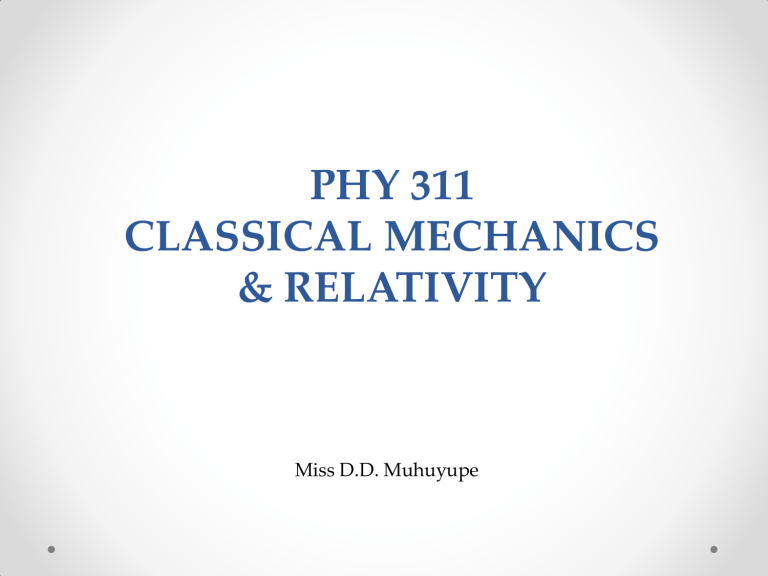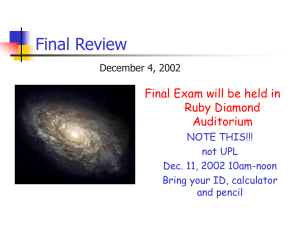
PHY 311 CLASSICAL MECHANICS & RELATIVITY Miss D.D. Muhuyupe UNIT 2: NEWTONIAN MECHANICS NEWTONIAN MECHANICS The Earth and our Solar System General Notions of Astronomy Stars: Stars are celestial objects (suns) mostly of high mass concentration that emit light produced by nuclear reactions. In the core zone of our sun, for example, hydrogen (H) is burning to helium (4He). In other, older stars, higher burning processes are going on, such as 34He → 12C, 12C +4He →16O, etc. Planets: Planets are bodies circulating in the central force field of a star. They may reflect light (the ratio of reflected to incoming luminous flux is called albedo), but hardly emit any light by themselves (up to some thermal radiation corresponding to their temperatures). The point of maximum distance between a planet and its central body is called aphelion, the point of minimum distance is called perihelion. Meteors: Collective noun for the light phenomena that are caused by penetration of solid particles (meteorites) into the earth‘s atmosphere. The meteorites that may have masses between 10−3 g and 106 kg enter the atmosphere with velocities between 10 and 200 km/s and usually burn out completely. Comets: Comets are celestial bodies of low mass concentration (most likely all of them) moving in the central force field of a star. A comet has a core out of dust and ice grains. Under sufficient irradiation by the sun it develops a gas shell (coma) and a tail. The total length may reach up to 300 millions of km. Satellites: Satellites are bodies circulating about planets. One may distinguish between natural satellites, the moons, and artificial ones (the first one was Sputnik I (10/14/1957)).In the case of earth satellites, the longest and shortest distance from earth is denoted as the apogee and perigee, respectively. Asteroids and planetoids: These are pieces of rock. The size is small as compared to the usual planets. They are orbiting about the sun in the range between Mars and Jupiter and mostly have similar orbital data. Therefore, they were presumed to be the residues of a decayed planet (the orbits of the planetoids are crossing each other). There are also commensurability gaps within the belt of planetoids, presumably caused by Jupiter. Period: The period denotes the time of a full course of any periodic motion. In astronomy one mostly means the sidereal period, namely, the time a mass needs for a complete revolution about its central body. Solar system: The sun together with its associated planets and their moons, as well as the planetoids, comets, and swarms of meteors, in total constitute the solar system. . Ecliptic: The plane in which the center of mass of the system earth–moon orbits around the sun is called ecliptic. Determination of Astronomic Quantities The distance between planets and earth: a) The distances may be determined by triangulation. From a measurement of the observation angles of the planet as seen from two distinct points and of the distance between these points, the distance of the planet may be calculated. (b) Distances may be measured by radar. Because the propagation speed of electromagnetic waves is known, one may conclude from the transit time of radar signals on the distance. This method works only for the immediate neighbours of the earth. (c) In the sense of (a), the earth‘s orbit may also be used as a base for triangulation to measure the distance of the near fixed stars. (d) The sun (and the planets) are moving uniformly by about 610 millions of km/year (or astronomic units per year) toward the sun‘s apex in the constellation of Hercules. This may also be used for parallax measurements, and thus for measuring the distances of fixed stars up to more than 100 light years. Determination of the Distance of far away Astronomical Objects: The universe is expanding. The farther away the astronomical objects are, the larger their velocity is. The Hubble law allows the determination of the distance 𝑑 of extragalactic objects from their recessional velocity 𝑣 if the numerical value of the constant 𝐻0 is known. Hubble law: 𝑣 = 𝐻0 𝑑 Matter that has been created with high initial velocity travels the longest distance within time 𝑇 ∶ 𝑑 = 𝑣𝑇 thus 1 𝑇 𝑣 = ·d. . For nonrelativistic speeds, the recessional velocity 𝑣 equals the product of the speed of light and the redshift 𝑧, which can be measured in the spectrum of the observed object, 𝜆 − 𝜆0 𝑧= 𝜆0 Here, λ is the observed wavelength of a reference line in the line spectrum of the object and 𝜆0 is the wavelength of this line when the relative velocity between source and observer vanishes. If the period of the emitted light is T, we have 𝜆0 = 𝑐𝑇 and λ = (𝑐 + 𝑣)𝑇, 𝑜𝑟 𝜆0 𝜆 = 𝑐 𝑐 + 𝑣 ,from which we obtain 𝑣 = 𝑧𝑐. In order to obtain the Hubble constant 𝐻0 , the distances of a suitable sample of galaxies have to be measured. Astronomical distances are usually measured step by step, progressing gradually from the solar system over nearby stars to ever more distant objects, finally reaching faraway galaxies. Method of triangulation. (Direct Determination) The change of the direction to a star when observing from two different points at a distance d is measured. The line between the two observation points is called the 𝑏𝑎𝑠𝑒𝑙𝑖𝑛𝑒; the angle difference is called the 𝑝𝑎𝑟𝑎𝑙𝑙𝑎𝑥 of the star. The parallax is the same angle under which the baseline would be seen when observed from the star. The distance to the star can then be calculated by simple trigonometry. . In the ideal (and most simple) case, the observed star lies in the plane perpendicular to the baseline and cuts the baseline in half. Then, the distance is, to a very good approximation, given by 𝑏 𝑑 = 𝛼 where 𝑏 is the length of the baseline and 𝛼 is the parallax angle. The longest available baseline is the line between two opposite points of the earth‘s orbit around the sun. This is also the origin of the distance unit of Parsec (pc). One pc is the distance from which the orbit of the earth is seen under an angle of one arc-second, or, equivalently, the distance yielding a parallax of one arc-second. 1 Parsec = 3.26 light years. Star drift parallax (also called convergent-point method) The method of the star drift parallax is based on the determination of the two components of a star‘s motion that can be observed from the earth: The 𝑟𝑎𝑑𝑖𝑎𝑙 𝑣𝑒𝑙𝑜𝑐𝑖𝑡𝑦 (the velocity along the line of sight) can be measured from the Doppler shift in the spectrum of the star, while the proper motion of the star (the motion on the celestial sphere) can be converted to the 𝑡𝑟𝑎𝑛𝑠𝑣𝑒𝑟𝑠𝑎𝑙 𝑣𝑒𝑙𝑜𝑐𝑖𝑡𝑦 if the distance of the star is known. Both velocity components taken together yield the compete, three-dimensional velocity vector of the star. If the direction of the velocity vector and the radial velocity of a star are known, the distance of the star can be calculated from the proper motion.. The orbital velocity of the planets: a) For circular orbits the velocity may be determined from the measurable quantities orbital radius and revolution time (period). b) For elliptic orbits the velocity may be determined from the measurable quantities semi-axes and period. The mass of the planets: (a) From the gravitational law and the equation for the centripetal force the relation 𝛾𝑀 = 4𝜋 2 𝑎3 𝑇 −2 follows; This is the third Kepler law. 𝑀 means the mass of the central body, which is large as compared to the mass of the orbiting body. From this equation one may calculate the mass of the sun and the mass of every planet having moons. (b) If planets don‘t have moons, their mass is determined from the orbital perturbations of the neighboring planets. The rotational velocity of a planet or star: The rotational velocity of a planet may be determined by observation of marked points on its surface. For stars that are visible only as a point-like light source, this method fails. For these objects the rotational velocity may be derived from their spectra and from the distortion of a spectral line due to the Doppler effect (distinct shift—red, blue—at opposite sides of the rotating star). The east border of the sun shows, for example, a red shift, and the west border a blue shift from which follows a rotational velocity of the surface of the sun of 2 km/s. Detection of gases in the universe: Elements occuring in stars may be determined from the spectrum of the star light. In the case of planets one has to take into account that they only reflect or absorb light. The gases of the atmosphere may be identified by the absorption spectrum (Fraunhofer lines). The tides: Two masses are moving in the gravitational field of a third mass M (see figure). Two masses in the gravitational field of a mass M are subject to different accelerations 𝑎1 and 𝑎2 due to the inhomogeneities of the gravitational field. The distinct magnitude of the gravitational force implies a force between the two masses, which there by are pulled apart from each other. Such a force always arises if the gravitational field is inhomogeneous; it is called a tidal force because the tides on earth are caused by the same effect. Precession and nutation of the earth: Nutation and precession are the periodic and long-term motion of the Earth‘s spin axis in space. The direction of the Earth‘s axis in space, changes over time with respect to extremely distant objects such as quasars Nutation is caused by the changed in the location of the Sun and Moon. Nutation is ‗Nodding‘ motion, precession is the ;wobbling‘ motion. Properties, Position, and Evolution of the Solar System Properties, Position, and Evolution of the Solar System General Facts on the Solar System • Our solar system belongs to the spiral nebula ―Milky Way.‖ • Our solar system is about 10 kpc apart from the center of the galaxy. (1 pc = 3.086 ·1013 km= 3.26 lightyears..) Properties, Position, and Evolution of the Solar System General Facts on the Solar System • Our solar system belongs to the spiral nebula ―Milky Way.‖ • Our solar system is about 10 kpc apart from the center of the galaxy. (1 pc = 3.086 ·1013 km= 3.26 lightyears..) Evolution of the solar system: A sun is formed if a dense cloud of interstellar gas and dust contracts under the action of the gravitational force. Our sun is surrounded, however, by many other bodies forming the planetary system. The evolution of this planetary system is at present not yet fully understood. There are competing theories that always explain only some of the properties of the planetary system. The multitude of theories may be grouped into three main classes that differ in the mechanism of formation of the planets. Evolution of the solar system: 1. Theories stating that the formation of planets is independent of the formation of the sun: The planets only emerged when the sun was already a normal star. This class includes, for instance, the tidal theories. 2. Theories stating that after the formation of the sun, the planets were generated from interstellar matter. These are the so-called accretion theories, which assume an increase of mass within a plane (the ecliptic). 3. Theories according to which the planets are formed out of the same nebula and by a similar process as the sun is formed (nebular hypotheses). 1. Tidal theories (Bickerton, 1878; Chamberlain, 1901; Moulton, 1905; Jeans, 1916; Jeffreys, 1918) : Two suns pass each other but without mutually capturing each other. Due to the tidal forces, matter is pulled out of the suns that shall condensate to planets. Aside from the low probability of such an encounter, this theory has several further deficiencies. It could in no way explain the chemical composition of the planets, and the planet orbits should be strongly elliptic according to this theory. Moreover, some later calculations (Spitzer, 1939) showed that matter ejected by a star cannot condense to a planet, because of its high temperature. Therefore, the tidal theories meanwhile have been dropped. 2. Accretion theories (Hoyle and Littleton, 1939) If the sun moves through a cloud of interstellar matter, it can bind particles by the gravitational force. Due to the attractive force between the particles and by collisions, larger masses may be formed that shall grow up to the size of the present planets. One also has to take into account the consequences of electromagnetic effects (Alfven, 1942). The magnetic field of the sun prevents a particle with charge 𝑞 and mass m to come closer to the sun than to a critical radius 𝑟𝑐 , which is proportional to 𝑞 𝑚 2 3 . Therefore, the heavier particles pile up near the sun. By appropriate assumptions on the magnetic field of the sun, the chemical composition of the planets may be roughly explained. 3. Nebular theories (Descartes, 1644; Kant,9 1755; Laplace, 1796) The gas nebula from which the sun originated was flattened by its rotation. Because of turbulences, parts of the nebula split off, which then begin to contract. They thereby rotate faster and faster because the angular momentum is conserved. The central part of the nebula forms the sun, while the peripheral region leads to many proto-planets. In the interior of these proto-planets a core evolves from the solid fractions of the nebula. The number of proto-planets may decrease by collisions. This theory may explain the formation of Jupiter and Saturn. World views • Geocentric—the Ptolemaic world view (about 140 AD) • The Heliocentric System—the Copernican World View Geocentric—the Ptolemaic world view (about 140 AD) The Ptolemaic world view was the base of astronomy until the 17th century. It considers the earth as the world center being at rest. The moon, sun and the planets orbit about earth. The Heliocentric System—the Copernican World View In the Copernican world view, the sun is understood as the center (central body) of our planetary system. It culminated in Kepler‘s laws that allowed one to calculate all processes in the planetary system easily and exactly. The Spatial Motion of the Sun From the spatial motion of the stars one may conclude that our sun also moves through the universe. The method of how to determine this motion is illustrated by the following example: A driver moves by car along a straight road through the woods. To learn about the direction and speed of motion one might derive it from the motion of the trees. When looking; i) forward, trees seem to diverge. ii) perpendicular, the trees seems to be in backward direction. iii) backward, the trees seem to converge The same holds also for the motion of the sun through the universe: One has to observe the systematic effects of motion of the stars. A complication as compared to the case of the moving car, however, is due to the fact that the stars don‘t stand fixed as the trees, but are moving by themselves. But one may expect that in a statistical observation of very many stars the individual motions of the other stars will no longer show up too much, such that the effect described above manifests itself clearly. Radial velocities have the largest negative value in the direction of the apex, the largest positive value in the direction of the Antapex (dashed double arrows). The tangential velocities of stars are largest in the direction vertical to the sun‘s motion (bold arrows), whereas the radial velocities there are smallest. The position of the sun apex in the constellation of Hercules. Our solar system as a whole—located in the Orion branch of the Milky Way—moves toward the apex with a speed of 19.4 km/s ≈ 610 million km/year. Neighbourhood of our Milky Way Our spiral nebula, the Milky Way, is embedded within the socalled local group, a cluster of about 9–10 galaxies. The Milky Way and the Andromeda nebula, just as the M33galaxy, are spiral nebulas; all other galaxies are of a type of spherical clusters. The first group of galaxies outside the local group is located toward the constellation Virgo consisting of 2500 galaxies and is at a distance of about 60 million lightyears away. the ratios of distances: • Our Milky Way has a diameter of 105 lightyears • the mean distance of two stars within the MilkyWay is about 5 lightyears. • The Andromeda nebula is separated from the Milky Way by 2 ·106 lightyears. • The Milky Way is further ―orbited‖ by two small satellite galaxies: The Small and the Large Magellanic Cloud. On the Evolution of the Universe Our knowledge about the beginning of the universe is rather obscure, because it was born out of a state which cannot be described by any physical law we know of. We simply call these indescribable moments of birth of our universe the Big Bang. It ‖ must have happened about 14 ·109 years ago. The evolution of the universe: Modern physics and experimental observations document the history of the universe from an incremental fraction of time after the Big Bang some 14 billions of years ago up to its present state. Dark matter is seen today as having played a key role in the formation of stars and galaxies. (©CERN Publications, July 1991, reproduced with kind permission) The Cosmic Background Radiation About 300 thousand years after the Big Bang, radiation had not enough energy left to interact with matter because the excited states of atoms were appreciably higher than the photon energies contained in the cosmic radiation. Therefore, the universe became transparent for electromagnetic radiation. Dark Matter Where does dark matter come from? Dark matter is the mysterious stuff that fills the universe but no one has ever seen. Over 80% of all matter in the universe is made up of material scientists have never seen. It's called dark matter and we only assume it exists because without it, the behaviour of stars, planets and galaxies simply wouldn't make sense. WHAT IS DARK MATTER AND WHY IS IT INVISIBLE Dark matter is completely invisible. It emits no light or energy and thus cannot be detected by conventional sensors and detectors. The key to its elusive nature must lie in its composition, scientists think. Visible matter, also called baryonic matter, consists of baryons — an overarching name for subatomic particles such as protons, neutrons and electrons. Scientists only speculate what dark matter is made of. It could be composed of baryons but it could also be non-baryonic, that means consisting of different types of particles. Most scientists think that dark matter is composed of nonbaryonic matter. The lead candidate, WIMPS (weakly interacting massive particles), are believed to have ten to a hundred times the mass of a proton, but their weak interactions with "normal" matter make them difficult to detect. Neutralinos, massive hypothetical particles heavier and slower than neutrinos, are the foremost candidate, though they have yet to be spotted. Sterile neutrinos are another candidate. Neutrinos are particles that don't make up regular matter. A river of neutrinos streams from the sun, but because they rarely interact with normal matter, they pass through Earth and its inhabitants. There are three known types of neutrinos; a fourth, the sterile neutrino, is proposed as a dark matter candidate. The sterile neutrino would only interact with regular matter through gravity. "One of the outstanding questions is whether there is a pattern to the fractions that go into each neutrino species," Tyce DeYoung, an associate professor of physics and astronomy at Michigan State University and a collaborator on the IceCube neutrino observatory in Antarctica, told Space.com. The smaller neutral axion and the uncharged photinos — both theoretical particles — are also potential placeholders for dark matter. There is also such a thing as antimatter, which is not the same as dark matter. Antimatter consists of particles that are essentially the same as visible matter particles but with opposite electrical charges. These particles are called antiprotons and positrons (or antielectrons). When antiparticles meet particles, an explosion ensues that leads to the two types of matter cancelling each other out. Because we live in a universe made of matter, it is obvious that there is not that much antimatter around, otherwise there would be nothing left. Unlike dark matter, physicists can actually manufacture anti-matter in their laboratories. Our galaxy (Milky Way) as seen schematically from a distant point in the galactic plane. Dark matter forms a large halo extending far outside the outer edges of the galaxy. (From K. Pretzl, Spatium 7, May 2000 ©Association Pro ISSI, reproduced with kind permission). WHY DO WE THINK DARK MATTER EXISTS But if we cannot see dark matter, how do we know it exists? The answer is gravity, the force exerted by objects made of matter that is proportional to their mass. Since the 1920s, astronomers have hypothesized that the universe must contain more matter than we can see because the gravitational forces that seem to be at play in the universe simply appear stronger than the visible matter alone would account for. "Motions of the stars tell you how much matter there is," Pieter van Dokkum, a researcher at Yale University, said in a statement. "They don't care what form the matter is, they just tell you that it's there." Astronomers examining spiral galaxies in the 1970s expected to see material in the center moving faster than at the outer edges. Instead, they found the stars in both locations traveled at the same velocity, indicating the galaxies contained more mass than could be seen. Studies of gas within elliptical galaxies also indicated a need for more mass than found in visible objects. Clusters of galaxies would fly apart if the only mass they contained was the mass visible to conventional astronomical measurements Different galaxies seem to contain different amounts of dark matter. In 2016, a team led by Van Dokkum found a galaxy called Dragonfly 44, which seems to be composed almost entirely of dark matter. On the other hand, since 2018 astronomers have found several galaxies that seem to lack dark matter altogether. HOW DO SCIENTISTS STUDY DARK MATTER? Since we can't see dark matter, can we actually study it? There are two approaches to learning more about this mysterious stuff. Astronomers study the distribution of dark matter in the universe by looking at the clustering of material and the motion of objects in the universe. Particle physicists, on the other hand, are on a quest to detect the fundamental particles making up dark matter.





